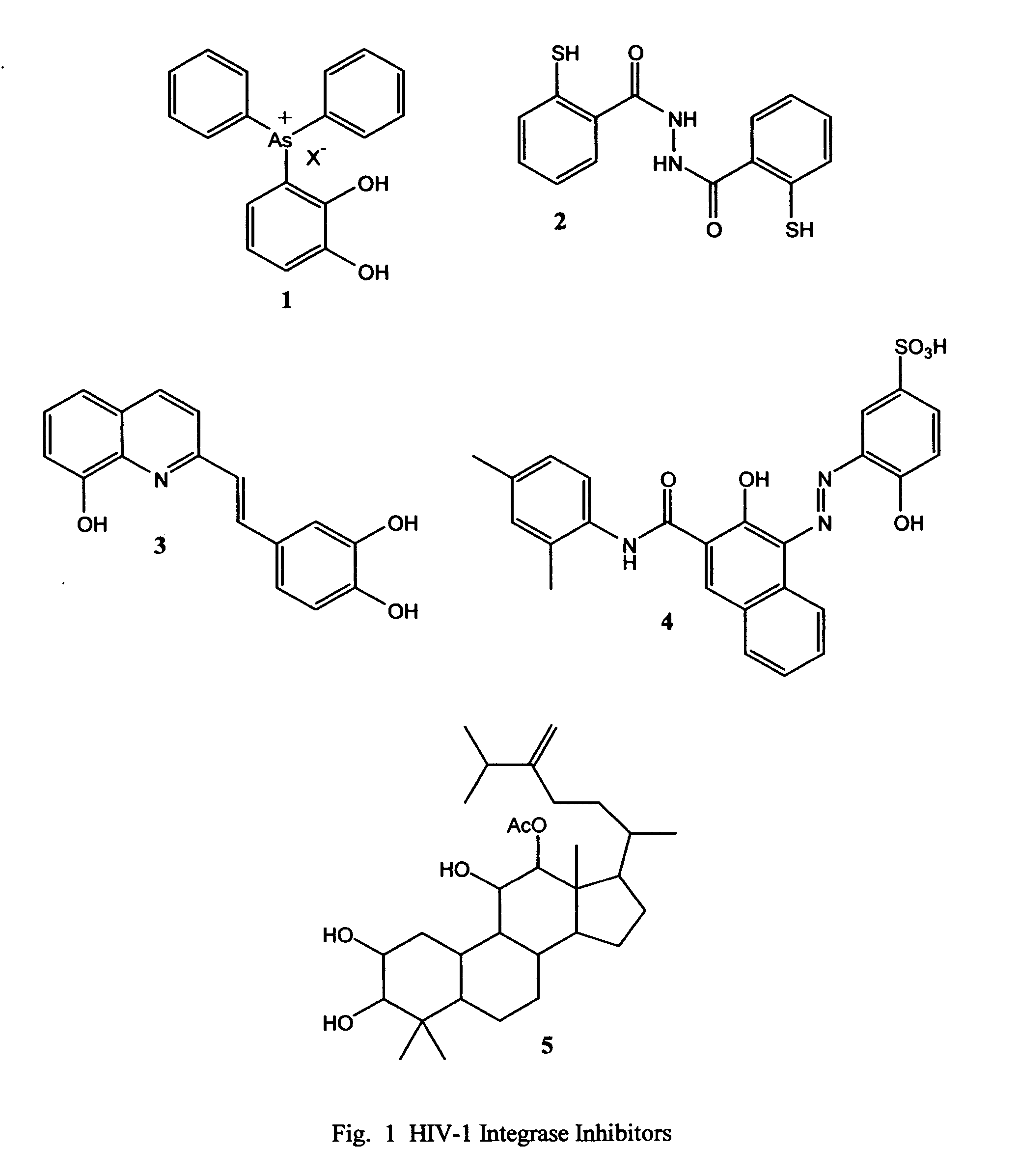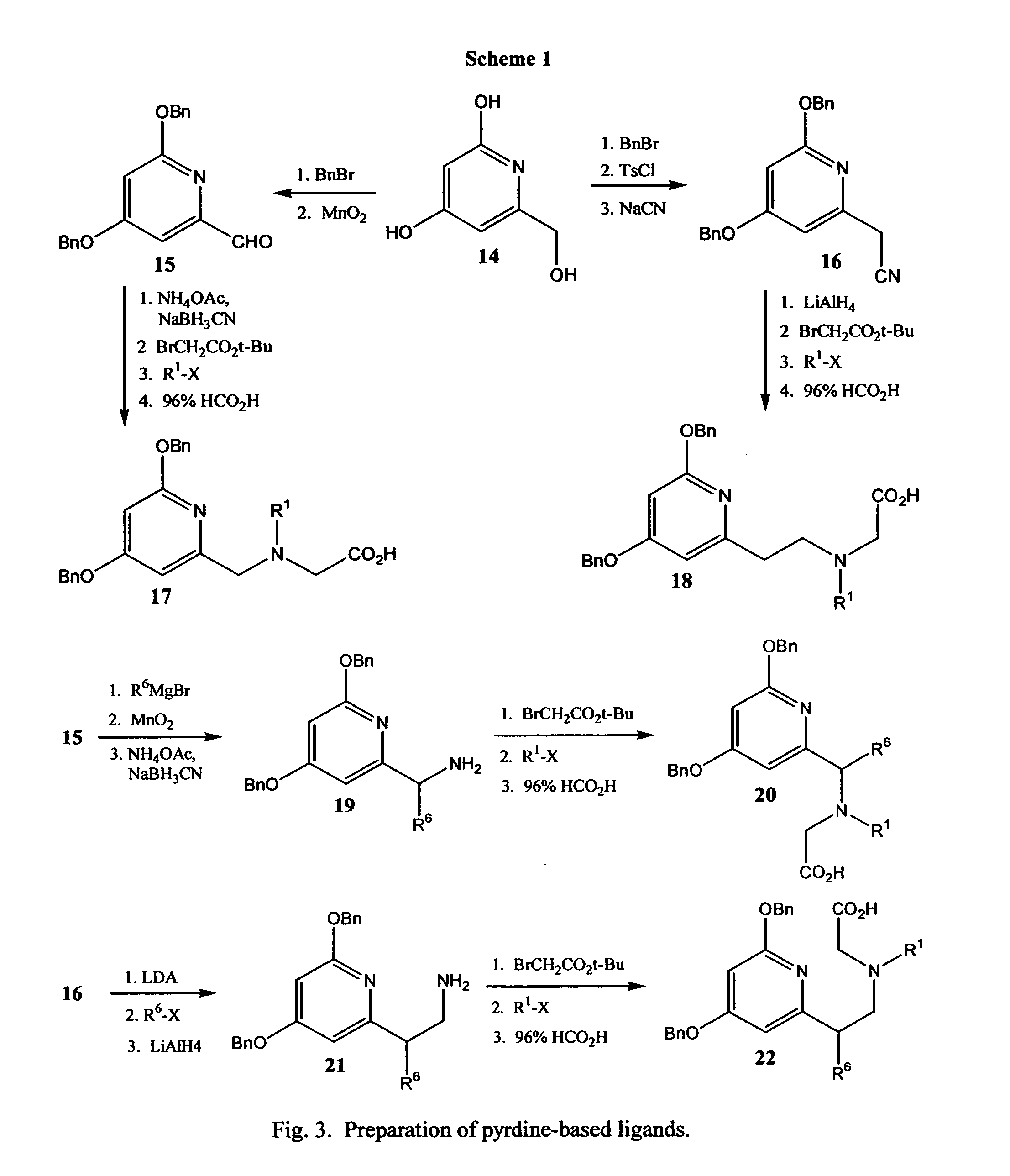Novel pyridine-based metal chelators as antiviral agents
a metal chelator and metal chelator technology, applied in the field of antiviral agents, can solve the problems of reducing bioavailability, reducing bioavailability, and reducing the effect of aldehydes and ketones
- Summary
- Abstract
- Description
- Claims
- Application Information
AI Technical Summary
Problems solved by technology
Method used
Image
Examples
example 1
[0040] Step 1. A mixture of the 2-(2-aminoethyl)pyridine (1.22 g, 10 mmol), t-butylbromo-acetate (4.1 g, 21 mmol), and finely ground anhydrous potassium carbonate (4.1 g, 30 mmol) in ethylene glycol dimethyl ether (DME) (20 mL) was heated under reflux for 1 hour. The TLC showed complete consumption of starting material. The reaction mixture was filtered hot, the solid washed with 30 mL of DME, and the filtrate evaporated in vacuo to give a dark brown gum. Purification by gradient flash chromatography (chlroroform / methanol, 0 to 5% over 1 hour) gave pure 2-[2-(N,N-bis(t-butoxycarbonyl)]ethylpyridine. Proton and carbon NMR spectra were consistent with the desired structure.
[0041] Step 4. A solution of the di-t-butylester (1.75 g, 5 mmol) from Step 1 was treated with 3M HCl in tetrahydrofuran (5 mL) and kept at at ambient temperature 16 hours. The white precipitate is collected by filtration, resuspended in absolute ethanol, heated to boiling, and filtered to give the desired diacid i...
example 2
Preparation of Inhibitor 17, Wherein R1 is Carboxymethyl.
[0042] Step 1. A mixture of 2,4-dihydroxy-6-hydroxymethylpyridine, (10 mmol), benzyl bromide (21 mmol) and finely ground anhydrous potassium carbonate (30 mmol) in ethylene glycol dimethyl ether (DME) (20 mL) is heated under reflux for 8 hours. The reaction mixture is filtered hot and solid is washed with 30 mL of DME. The filtrate is evaporated in vacuo and the crude product is purified by recrystallization or chromatography to give pure 4,6-dibenzyloxy-2-hydroxymethylpyridine.
[0043] Step 2. A mixture of the pyridylcarbinol (10 mmol) from Step 1 and activated manganese dioxide (2 g) in methylene chloride (20 mL) is stirred at ambient temperature for 16 hours. The reaction mixture is filtered, and the filtrate is washed with 30 mL of methylene chloride. The filtrate is evaporated in vacuo and the crude product is purified by recrystallization or chromatography to give pure 4,6-benzyloxy-2-pyridinecarboxaldehyde.
[0044] Step...
example 3
Preparation of Inhibitor 18, Wherein R1 is Carboxymethyl.
[0047] Step 1. A mixture of the pyridylcarbinol (10 mmol) from Example 2, Step 1 and triethylamine (12 mmol) in methylene chloride (20 mL) is stirred and cooled to 0° C. Thereafter, p-toluenesulfonyl chloride (10.5 mmol) is added dropwise while maintaining the temperature at 0-5° C. After the addition, the reaction mixture was stirred at ambient temperature for 16 hours. The reaction mixture is poured onto water and the organic layer is separated, washed with brine, dried over anhydrous sodium sulfate, filtered, and the filtrate evaporated in vacuo to give the tosylate, which is purified by chromatography or recrystallization.
[0048] Step 3. A mixture of the tosylate (10 mmol) from Step 2, and sodium cyanide (12 mmol) in dimethylsulfoxide (DMSO) (10 mL) is heated under reflux for 16 hours. The reaction mixture is poured onto water and extracted with ether. The organic layer is separated, washed copiously with water to remove...
PUM
| Property | Measurement | Unit |
|---|---|---|
| volume | aaaaa | aaaaa |
| temperature | aaaaa | aaaaa |
| temperature | aaaaa | aaaaa |
Abstract
Description
Claims
Application Information
 Login to view more
Login to view more - R&D Engineer
- R&D Manager
- IP Professional
- Industry Leading Data Capabilities
- Powerful AI technology
- Patent DNA Extraction
Browse by: Latest US Patents, China's latest patents, Technical Efficacy Thesaurus, Application Domain, Technology Topic.
© 2024 PatSnap. All rights reserved.Legal|Privacy policy|Modern Slavery Act Transparency Statement|Sitemap



